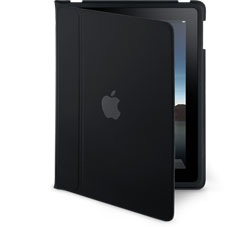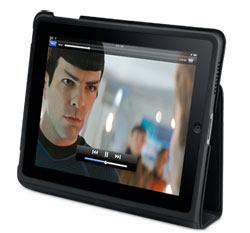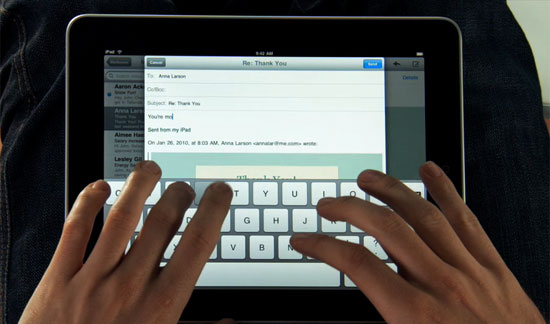The Apple iPad - Anand's Analysis
by Anand Lal Shimpi on January 27, 2010 5:00 PM EST- Posted in
- Smartphones
- Mobile
Will it Work...Literally
Today my issue with the iPhone (and netbooks for that matter) is that they are very limited when it comes to productivity. I don’t have a good solution if I need the performance, usability and capabilities of my notebook, but want something lighter to carry around with me. You could always get a CULV notebook or from Apple something like the MacBook Air, but that’s still a notebook. There is no perfect blend of notebook functionality with smartphone portability. If the iPad can achieve that, at least in the same manner that the iPhone did for smartphones, then I will consider it worth the hype.
Achieving that goal requires a delicate balance of the right UI, the right hardware (including ergonomics) and the right functionality.
The UI looks clean and snappy. Apple’s biggest omission here appears to be multitasking support. One of the most frustrating things about using an iPhone is its inability to do two serious tasks at once. Email + Web browsing, Pandora + anything. You get the point. This is perhaps a temporary issue. The iPad runs iPhone OS 3.2 as of today. The next major release of the iPhone OS, version 4.0, is expected to add multitasking support. This could presumably make its way onto the iPad later this year (or early 2011?).

Yeah that looks super comfortable...
The hardware looks good. It remains to be seen whether or not it’s actually comfortable to hold a 1.5 lbs tablet while you type on it. Although Apple has a couple of accessories that look to address that issue:
 |  |
 |  |
The software keyboard looks like it could work well, if it’s combined with the same sort of predictive trickery that the iPhone uses. I’ve been asking for the sort of tablet the Enterprise crew (Star Trek, not the server market) carried around. The iPad’s interface, at least what I’ve seen of it, has the most potential to deliver that sort of experience. The iPad UI could be something that feels like it was made in 2010, not 2002.

The functionality is also a big unknown. When the iPhone first launched its killer apps were the ones that Apple made for it. While the App Store is far more mature now, the iPad will need some key functionality for it to be a productivity device.
Porting iWork ($9.99 per app) to the iPad was necessary. The fact that Apple did this right off the bat indicates that at least someone over there knows that the market for a $500 - $900 toy is slim. But we need more. We need things like Photoshop for the iPad. Dare I say that we even need a port of Microsoft Office?
At CES everyone talked about tablets and eReaders being huge at the show. I saw a lot of neat devices, but nothing I’d want to go out and buy. The iPad is the first one I’ve seen with potential. And much like the iPhone before it, whether you like it or not is irrelevant - it will at least pave the way for other companies to emulate and improve upon the design.










155 Comments
View All Comments
muretu - Wednesday, January 27, 2010 - link
Great article. I do think that iPad is a great alternative somewhere between MacBooks and the iPhone. Apple have defiantly coupled a good build and a solid O.S. together, again.Funny how it hardly has been noticed that Microsoft have been doing this for years, re-releasing new touch PC's.
The iPhone was an innovation (with the multi touch glass display). The iPad is not exactly necessary at it's current stage. I'm sure the MacBook's are fine for now, if you thought iPad was a computer replacement.
Would be interesting to see a fully operational Mac OS X Leopard running of a tablet.
But it's Apple's great O.S'. and price range which has sold their products from the past. :)
hwhacker - Wednesday, January 27, 2010 - link
Price helps sell their products? Wut?jimhsu - Wednesday, January 27, 2010 - link
Conspicuous consumption (aka the Veblen goods theory). The fact that apple has higher prices obviously suggests to the (usually uneducated) consumer that the goods in question are of a higher quality. It's worked fantastically for the LVHM conglomerate, at least.The new macbooks (in relation to the Rev A MBP) are of a more reasonable price, though.
Sahrin - Wednesday, January 27, 2010 - link
I'm not the biggest fan in the world of Apple. A lot of the hardware community (starting with AT and Ars) fawns all over them, which is something I simply can't understand. No Hardware company ever got this kind of affection before the "Apple reinessaince" of the last 3 years. That's why I don't like Apple. They have good hardware - sometimes. They have good software - sometimes. The only thing they do that truly differentiates themselves from their competitors all amounts to showmanship. Instead of putting a device into beta testers hands a year in advance (a la Microsoft or the console makers) Apple announces it in such a way as to manufacture the most 'buzz' (and everyone falls for it); it launches with almost zero software support (meaning it is useless) - but everyone loves it anyway. The reason usually given for the love? "The sparse environment is so modern and aesthtetically pleasing."That said, I actually was pretty stoked about the iSlate (which was what at the time I assumed it would be called). It is EXACTLY the kind of product I could see myself getting. I am not a big phone guy, I like connectivity but talking on the phone is a single-thread activity; I work in multiple instances in multiple dimensions. I really love the concept of the tablet - and have ever since Microsoft really started pushing the format.
(That's my second point, Anand. Twice in this article you cite Apple as the 'inventory' or 'first person in' to a market - you're absolutely wrong on both counts. It seems like every serious hardware guy who goes over to Apple becomes a fanboy - totally ignorant of the facts, and re-writes history to fit their vision of the world. The same happened to Jon Stokes. What's the deal?)
So, as I said, I was really, really excited for the iSlate. I don't like PMP's because the video is unworkable - and if you just want an MP3 player what's the point of the screen anyways? The most exciting parts of the ZuneHD are HD Radio and Zune Pass and portable gaming. Video isn't even on the list.
But an iSlate-like device could really change the way people use technology. I was a big fan of Earth: Final Conflict and I've always felt that the "Global" device used in that show was the future of communications. A portable screen which gives person a thin but robust computing appliance and handles all personal tech interface. You still have a desktop for serious work, but most of the utility stuff ironically gets moved to the iSlate.
So imagine my surprise when, as a non-Apple fanatic, I found myself *VERY* excited for the iSlate.
And Apple delivered the iPad.
This is *not* the device I was told to expect. The only thing it really has in common with the device I want is 3G and touch screen.
DO NOT WANT:
iPhone OS.
Apple Content Lock In.
iBook store (see above)
Lack of Flash/Silverlight support
Light ARM processor
$800 device
DO WANT:
Multi-core full-feature x86 CPU. Will settle for Tegra2 SoC.
Video acceleration
Full Desk Client OS. Preferrably Win7, so I can run all the software I want. Settle for OSX or Ubuntu in a pinch.
Same feature set of 64GB/3G for $500
I was actually very surprised to learn about the initial price point, until I heard about the 3G. It's not useless without 3G, but without 3G it isn't the same device. It's another laptop on the couch, as Anand put it so eloquently.
The Inside:
If you look at the specs, there's actually only one company that's really positioned at all to deliver the device that I'm talking about in the next 5 years. It's name starts with an A. And ends with an MD.
AMD can make their fortunes here. Designing a light SoC and tap Qualcomm/etal for radio support. Ideally a Bulldozer based solution which would support hardware backed SMT (cut down on core count) tied with 5000-series-class DX11 acceleration. Runs Win7. Access to all the content the web has to offer - which is 1 billion times better than iTunes or iBook store.
Please make this device. Apple has shown you it can be done at the right price point. Think about that last sentence, Dell/HP/MS/AMD/Intel. APPLE has shown you how something can be AFFORDABLE!
DO IT!
That said, I am still very interested in the iTab. It looks to be a great device, especially if they get the mutli-tasking problem licked in iPhoneOS4 and add in Flash/Silverlight.
Yay technology!
jasperjones - Wednesday, January 27, 2010 - link
+1Particularly, Apple vendor lock-in really scares me.
You want an Office app? Shell out $30 for iWork. I doubt Apple will allow anything akin to an OpenOffice port in the AppStore for the iPad.
jimhsu - Wednesday, January 27, 2010 - link
Agreed. I question whether your request (x86 modern CPU, "discrete" graphics, 64GB of flash, touchscreen, 3G modem, long battery life) is doable for $500 though. Such a device will likely be $800, and hype/demand/shipping/tax will probably drive that closer to $1000.Sahrin - Wednesday, January 27, 2010 - link
I agree that the x86 would push the cost up a bit, but the other side of it is that the manufacturing cost for x86 will be lower than it will be for ARM (because the 2 x86 manufacturers are ahead of any foundry). It will take some agressive work, but I think this is exactly the kind of thing bulldozer would be great at.The alternative is, of course, to port Win7 to ARM. MS needs to get on this right away. It would kill AMD, of course, (like overnight), but it would also really rejuvinate the PC hardware market. HP and Dell have been terrible stewards - all the innovation comes out of Taiwan.
If you can make a T&L laptop with Core2Duo for $600, then I really believe you can make a tab for about the same amount of money (smaller screen (always the most expensive part of a portable), fewer raw materials, no drive, smaller board, simpler board (no peripherial traces because it would have to be a SoC).
I agree that the price is probably north of $500, but I think it's less than $700 (maybe 699).
The main reason I ask for x86 is because I can take my Win7 desktop applications and (With a full x86 multicore) run them on the tablet piece of cake.
I would pay $1,000 for this because it would be useful to me, but cost is probably about $699.
MS could really hit a home run here, too, if they did some work and tied all the marketplaces (Zune, WinMo, XBL) together and used the Tablet as the "ambassador" device. The *BEST* part is that Apple took the STUPIDEST name for a tablet, meaning we can get something like "Slate" or "Canvas."
jimhsu - Thursday, January 28, 2010 - link
Our of those two possibilities, I would say x86 is the most likely one. Porting windows to ARM would be ... nasty. That said application compatibility with (real) OS X/Windows is sorely needed in this formfactor.The reason I quoted the given price is here: http://www.isuppli.com/News/Pages/iPhone-3G-S-Carr...">http://www.isuppli.com/News/Pages/iPhon...ing-Cost...
THE most expensive component in the iPhone is the screen+touch interface. The touch module is in fact almost the same price as the screen.
Sahrin - Thursday, January 28, 2010 - link
I'd say the change from x86 to ARM won't be as bad as you think - after all, they ported NT to IA-64 (and I don't have anything but a vague sense to back this up) which I think it a much bigger change than x86 to ARM. Totally different programming models, whereas x86 and ARM are fundamentally the same in the way they think about processing data, just different in the way the way they handle specific instructions.I agree with you, but the Bill of Materials you linked just enhances my point, I think. There is nothing the Slate needs that the iPhone has - so basically you scale the cost of the display 400%. Your BoM also doesn't include the cost of the battery (at least I don't see it).
By basically doubling the price of all components but RAM (x8 to get 2GB), Display (x4 for combined touch+display, which is probably a little strong), CPU ($50) and leaving the radios all the same (don't need a different radio) you get $397. Add in a baterry for...I don't know $50 you get $450. At $500 that's a gross margin of 10% (obviously nowhere near good enough, it needs to be way more than that - 40-50%), which gets you to $625 (including battery at 40% profit margin). Sell it for a handsom $74 profit per unit at $699, and you're doing quite well.
It's worth pointing out that my projections are significantly strong in hardware (I believe), but that puts it in my target range. $649 would obviously be better, and I really believe $599 is the sweet spot for such a device...but. Yeah.
I'm *really* excited for tablets, and if MS/PC OEM's don't have something by next winter I may just have to partake (especially if there is OSX or a much more fully-featured iOS4 available).
We'll see.
Ananke - Wednesday, January 27, 2010 - link
I believe the company that will make the most successful tablet device is Asus, followed by MSI, Acer and Lenovo. It is just a matter of time, and understanding to use attractive and durable case. Use metal or fiber, not cheap plastic; use Android or Win 7 with x.264 decoding, SDXC, USBs and HDMI out. Very simple mix to create the ultimate product. Just please do it :).